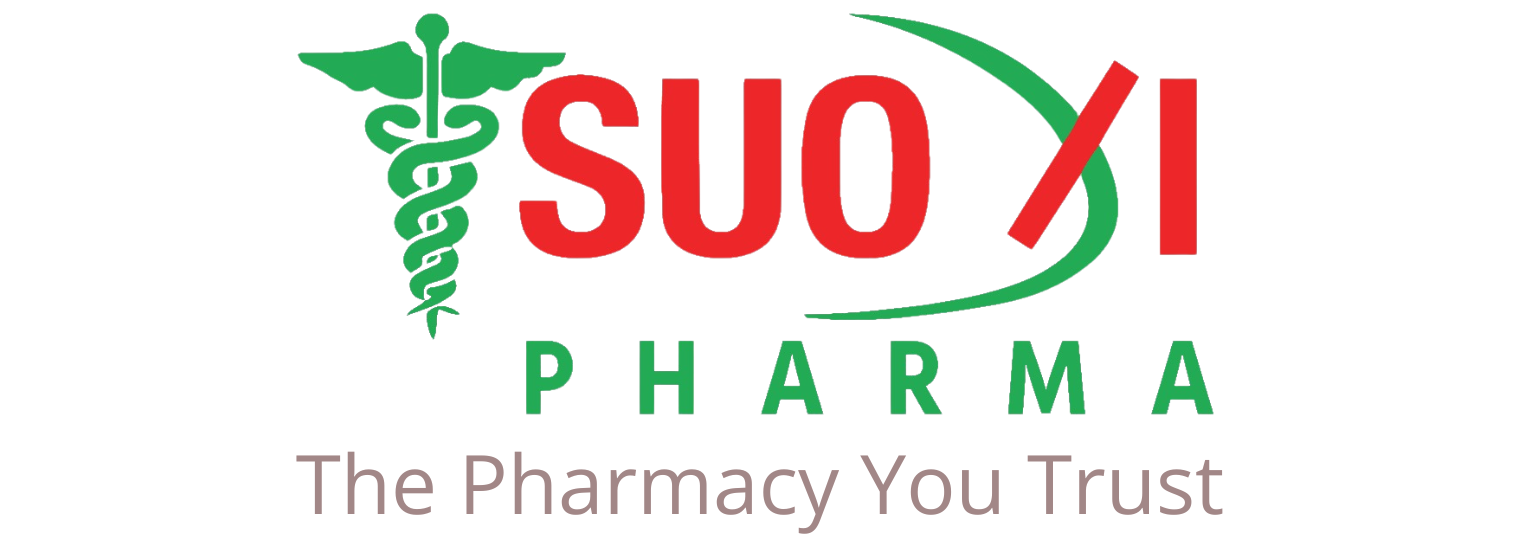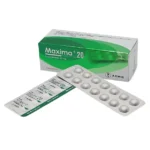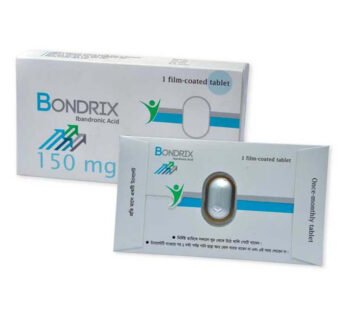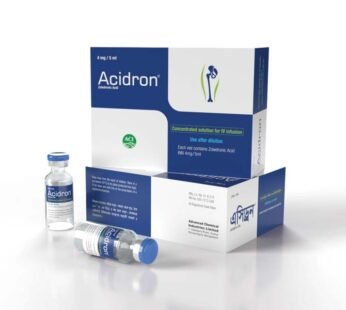Tridosil 500 mg

Description
Indications
Tridosil is used to treat a variety of infections caused by susceptible organisms. These include:
-
Lower respiratory tract infections such as bronchitis and pneumonia.
-
Upper respiratory tract infections like sinusitis and pharyngitis/tonsillitis.
-
Otitis media (middle ear infections).
-
Skin and soft tissue infections.
-
Sexually transmitted diseases (STDs) in both men and women, specifically non-gonococcal urethritis and cervicitis caused by Chlamydia trachomatis.
Use as directed by a registered healthcare professional.
Pharmacology
Azithromycin, the active ingredient in Tridosil, is acid-stable and can be taken orally without protection from gastric acid. It is absorbed well and its absorption rate is higher when taken on an empty stomach. The peak concentration in the blood is reached in 2.1 to 3.2 hours after oral administration. Azithromycin is highly concentrated in phagocytes (cells that engulf and digest foreign particles), allowing it to reach infection sites effectively. The concentration of azithromycin in infected tissues can be over 50 times higher than in plasma due to its high lipid solubility and ion trapping.
Azithromycin’s long half-life allows it to be administered as a single large dose and still maintain effective bacteriostatic (bacteria-inhibiting) levels in infected tissues for several days. After a 500 mg dose, plasma concentrations decline in a polyphasic pattern, with a terminal half-life of 68 hours. This long elimination half-life is attributed to the extensive uptake and release of the drug from tissues. Azithromycin is primarily eliminated through biliary excretion, largely unchanged. Only about 6% of the dose is excreted unchanged in urine.
Microbiology
Azithromycin works by binding to the 50S ribosomal subunit of susceptible microorganisms, disrupting their ability to produce proteins essential for their survival. It does not interfere with nucleic acid synthesis. Azithromycin is effective against most isolates of the following organisms:
-
Gram-positive bacteria: Staphylococcus aureus, Streptococcus agalactiae, Streptococcus pneumoniae, Streptococcus pyogenes.
-
Gram-negative bacteria: Haemophilus ducreyi, Haemophilus influenzae, Moraxella catarrhalis, Neisseria gonorrhoeae.
-
Other microorganisms: Chlamydia pneumoniae, Chlamydia trachomatis, Mycoplasma pneumoniae. Beta-lactamase production does not affect azithromycin’s activity.
-
Additional organisms: Streptococci (Groups C, F, G), Viridans group streptococci, Bordetella pertussis, Legionella pneumophila.
-
Anaerobes: Peptostreptococcus species, Prevotella bivia.
Dosage
-
Adults:
-
500 mg once daily for 3 days, or
-
500 mg on Day 1, then 250 mg once daily for the next 4 days.
For sexually transmitted diseases caused by Chlamydia trachomatis, the dose is 1 gm as a single dose or 500 mg on Day 1, followed by 250 mg once daily for 2 more days.
-
-
Children (over 6 months):
-
10 mg/kg body weight once daily for 3 days.
-
200 mg (1 teaspoon) for children weighing 15-25 kg for 3 days.
-
300 mg (1½ teaspoons) for children weighing 26-35 kg for 3 days.
-
400 mg (2 teaspoons) for children weighing 36-45 kg for 3 days.
-
In cases of typhoid fever, 500 mg once daily for 7-10 days is recommended.
-
Azithromycin Injection (IV infusion only):
-
Community-acquired pneumonia: 500 mg daily for at least two days intravenously, followed by 500 mg orally to complete a 7-10 day course.
-
Pelvic inflammatory disease: 500 mg daily for one or two days intravenously, followed by 250 mg orally for the next 5-6 days.
-
Note: The effectiveness and safety of azithromycin injection in children under 16 have not been established.
-
Use as directed by a registered healthcare professional.
Administration
-
For suspension:
-
Shake the bottle to loosen the powder.
-
Add boiled and cooled water to the water mark on the label.
-
Shake well until the powder is completely dissolved.
Azithromycin should be taken at least 1 hour before or 2 hours after meals.
-
Use as directed by a registered healthcare professional.
Interactions
-
Antacids: Take azithromycin at least 1 hour before or 2 hours after antacids.
-
Cyclosporin: Exercise caution when co-administering azithromycin and cyclosporin. Monitor cyclosporin levels.
-
Digoxin: Monitor digoxin levels, as azithromycin may raise digoxin levels in some patients.
-
Ergot derivatives: Avoid co-administration due to the risk of ergotism.
-
Methylprednisolone: No significant interaction observed.
-
Theophylline: No significant interaction observed, but monitor levels if co-administered.
-
Warfarin: No significant effect on warfarin’s anticoagulant action. Monitor prothrombin time regularly.
-
Terfenadine: No significant effect on the pharmacokinetics of terfenadine.
Contraindications
Azithromycin is contraindicated in patients who are hypersensitive to azithromycin or any other macrolide antibiotics. It should not be co-administered with ergot derivatives or used in patients with liver disease.
Side Effects
Tridosil is generally well-tolerated, with most side effects being mild to moderate. Common gastrointestinal side effects include nausea, abdominal pain, vomiting, flatulence, diarrhea, and loose stools. Rare side effects include allergic reactions like rash or photosensitivity, and more serious hypersensitivity reactions. Liver enzyme levels may rise temporarily, and in rare cases, cholestatic jaundice may occur. Reversible hearing impairment has been noted in some patients receiving higher doses for prolonged periods.
Pregnancy & Lactation
Azithromycin is categorized as Pregnancy Category B. Animal studies show no harm to the fetus, but there are no adequate human studies. Azithromycin should only be used during pregnancy when no safer alternatives are available. It is not known if azithromycin is excreted in breast milk, so caution should be exercised when administering it to nursing women.
Precautions & Warnings
Severe allergic reactions, including angioedema and anaphylaxis, have been reported with macrolides, including azithromycin. In rare cases, these reactions have led to prolonged symptoms.
Use in Special Populations
-
Renal impairment: No dose adjustment is needed for mild renal impairment. Caution is advised in patients with more severe renal impairment.
-
Hepatic impairment: Avoid use in patients with liver disease, as the liver is the main route of excretion for azithromycin.
-
Ability to drive and use machines: No evidence suggests that azithromycin affects the ability to drive or operate machinery.
Overdose Effects
Overdose symptoms may include hearing loss, severe nausea, vomiting, and diarrhea. Gastric lavage and supportive care are recommended in the event of an overdose.
Storage Conditions
Store in a cool, dry place, away from light and heat. Keep out of reach of children.
Chemical Structure
-
Molecular Formula: C38H72N2O12
-
Chemical Structure: Chemical structure of Azithromycin Dihydrate
Common Questions about Tridosil 500 mg Tablet
-
What is Tridosil 500 mg Tablet?
Tridosil 500 mg Tablet is an antibiotic that works by inhibiting bacterial protein synthesis, preventing bacteria from performing essential functions. -
What are the uses of Tridosil 500 mg Tablet?
It is used to treat infections like pneumonia, pharyngitis, skin infections, and sexually transmitted diseases caused by Chlamydia trachomatis. -
What are the side effects of Tridosil 500 mg Tablet?
Side effects may include diarrhea, abdominal pain, vomiting, and rash. Seek medical advice if side effects persist. -
How should Tridosil 500 mg Tablet be stored?
Keep it in a cool, dry place in its original packaging, out of reach of children and pets. -
Can Tridosil 500 mg Tablet cause diarrhea?
Yes, diarrhea is a common side effect but should resolve once the course of treatment is completed. Consult a doctor if diarrhea is severe or contains blood. -
Is Tridosil 500 mg Tablet safe?
Yes, when taken as prescribed by your doctor, it is safe for most people. -
What if my symptoms don’t improve after taking Tridosil 500 mg Tablet?
Contact your doctor if you do not see improvement after 3 days of treatment, or if your symptoms worsen.
Quick Tips
-
Complete the full course of treatment even if you feel better.
-
Take the tablet 1 hour before or 2 hours after meals.
-
Avoid antacids within 2 hours of taking Tridosil.
-
If you experience severe side effects, contact your doctor immediately.
Use as directed by a registered healthcare professional.
Additional information
| Weight | 0.15 g |
|---|







Reviews
There are no reviews yet.